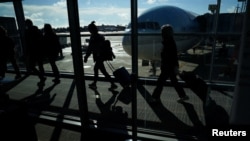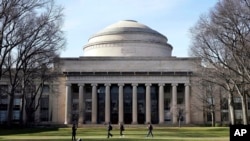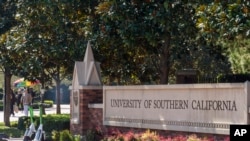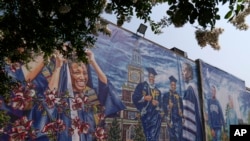Student Union
US Colleges, Universities See Sharp Losses During Pandemic

The number of foreign students studying at U.S. colleges and universities sharply declined for the school year that started in September 2020. Experts attribute the decline to the COVID-19 pandemic.
A survey of almost 3,000 institutions of higher education in the U.S. showed a 15% decrease in the number of international students attending the 2020-2021 school year.
The number of new student enrollments was slashed by 45.6%.
This brings the total of enrolled international students to 914,095, the first time since the 2015-2016 academic year the number fell below the 1 million mark after a decade of swift increases.
International students comprise 4.6% of the nearly 20 million students enrolled in U.S. higher education.
The number of students from China and India continue to dominate enrollment at U.S. colleges and universities. Combined, they continue to make up more than half of all the international students in the U.S.
Students from China declined by 14.8% from the previous year to 317,299, or 34.7% of all international students.
Students from India declined by 13.2% from the previous year to 167,583, or 18.3% of all international students.
The pandemic emanated from China in December 2019. International students left the U.S. to return to their home countries for winter break, with many returning to U.S. campuses in January 2020. U.S. campuses locked down in March 2020 around spring break, and all students were sent home, went home or remained in the U.S. as colleges and universities moved classes to online learning.
The research was conducted by the Institute of International Education (IIE), headquartered in New York, and released November 15. IIE, founded in 1919, is a nonprofit organization funded by the U.S. State Department, and it focuses on “international student exchange and aid, foreign affairs, and international peace and security,” according to its website. Its mission is to "build more peaceful and equitable societies by advancing scholarship, building economies and promoting access to opportunity."
New York University remained the top destination school for international students among all U.S. colleges and universities. New York state hosted the second-largest amount — 106,894 of the 914,095 total — after first-place California, which hosted 132,758 students. The University of Southern California moved from the third to the fourth slot – overtaken by New York City’s Columbia University – but the University of California campuses in San Diego, Los Angeles, Berkeley, Irvine and Davis were included in the top 18.
Northeastern University in Boston was the second most-popular school for international students: 15,880 of the 66,273 who attend school in Massachusetts. Another 10,646 international students attended Boston University, located nearby, among at least 10 other colleges and universities in an area known locally as the Miracle Mile.
IIE also released a more optimistic Fall snapshot that surveyed more than 860 institutions about enrollment for the school year that started in August and September 2021.
“The findings of the 2021 Fall International Student Enrollment Snapshot reflect the resilience of U.S. higher education institutions and student mobility during the COVID-19 pandemic,” IIE stated. “Higher education institutions report a 68% increase in the number of new international students enrolling for the first time at a U.S. institution in the U.S. or online from abroad, a surge from the 46% decline reported in Open Doors 2021.”
Of those 860 institutions, 70% reported an increase in new student enrollment, while 10% said enrollment was maintained and 20% reported a decrease.
As of fall 2021, 99% of colleges and universities that participated in the survey reported holding classes in person or a hybrid of in person and online. At least 65% reported having international students on campus.
Seventy-seven percent reported spending as much, if not more, on student recruitment compared to previous years.
See all News Updates of the Day
Malaysian official: Schools can’t turn away from global tensions

Zambry Abdul Kadir, Malaysia’s higher education minister, said protests spreading across universities in the United States show that schools can’t ignore political tensions.
Helen Packer, reporting in Times Higher Education, said the minister reminded educators that universities are key in the development of leaders, individuals and societies. (April 2024)
Social media breaks are difficult, but necessary

Between online classes, maintaining social connections and working on projects, college students can have a hard time disengaging from the demands of technology.
In Florida International University’s PantherNOW, Ariana Rodriguez offers strategies for taking a break from social media. (April 2024)
- By Melos Ambaye
Many master's degrees aren't worth the investment, research shows

Nearly half of master's degrees have a negative financial return, according to new research by the Foundation for Research on Equal Opportunity, an economic research organization.
The study indicates that many graduate degree programs do not increase lifetime earnings enough to be worth it.
While 23% of bachelor’s degree programs yield a negative financial return on investment, 43% of two-year degrees and master’s degrees fail to deliver a return, according to the study by Preston Cooper, a senior fellow at FREOPP.
Cooper assessed the return on investment for 53,000 degree and certificate programs to determine whether a student’s lifetime earnings outweigh program costs and the risk of not completing their degree.
His findings show that a student’s field of study was the overriding indicator of return on investment at the undergraduate and graduate level.
Engineering, computer science and nursing bachelor’s degrees have high financial returns on investment, while programs in education, fine arts, psychology and English usually have low returns.
Graduate degrees in medicine and law tend to have strong payoffs. But a large share of master’s programs, including the MBA, frequently have low payoffs, according to Cooper.
Although workers with master’s degrees earn 16% more than those with only bachelor’s degrees, Cooper says the figure fails to account for students who had “higher preexisting earnings potential.”
“MBA students typically have high preexisting earnings potential, having often chosen high-ROI undergraduate majors such as finance and economics,” Cooper writes. “So the MBA adds little value on top of that.”
The study indicates that high starting salaries are predictors of high returns on investment. Degrees with starting salaries of $57,000 a year or more deliver the best lifetime returns.
But the return on investment of a degree can vary depending on the educational institution.
“Students interested in fields with low average pay can still find some schools that do well transforming those fields of study into high-paying careers,” Cooper writes.
The quality of an institution also matters, said William Tierney, professor emeritus of higher education at the University of Southern California.
“An MBA from Harvard is a likely ticket to a good job,” Tierney told VOA. “An MBA from the University of Phoenix, less so.”
But students pursue graduate programs for more than just financial reasons.
“Some degrees open up careers in fields that students may enjoy, such as in the performing arts,” Robert Kelchen, head of educational leadership at the University of Tennessee, Knoxville, told VOA.
“Others can help gain access to social networks or simply help students learn about a topic that is of interest,” Kelchen added.
Cooper told VOA that it might make sense for students in degree programs with low returns on investment to switch majors if they can still graduate on time.
He found the worst outcome for a student’s return on investment is dropping out of college “because they must pay for one or more years’ tuition and spend time out of the labor force.”
Lawmakers who fund higher education have a responsibility in ensuring “higher education delivers on its promise of economic mobility,” Cooper said.
Nearly a third of federal funding, including Pell grants and student loans, pays for higher education programs that fail to provide students with a return on investment, according to the study.
Cooper’s view is that “some schools should shut down low-ROI programs and reallocate institutional resources to programs with a better return.”
“There's definitely this narrative out there that higher education is always worth it, and you should always try to get that extra degree because it will increase your earnings,” he told VOA. “That's reinforced by colleges who make lofty promises regarding their graduate degree programs' outcomes, which all too often fall short.”
Harvard students end protest as school agrees to discuss Gaza conflict

Protesters against the war between Israel and Hamas were voluntarily taking down their tents in Harvard Yard on Tuesday after university officials agreed to discuss their questions about the endowment, bringing a peaceful end to the kinds of demonstrations that were broken up by police on other campuses.
The student protest group Harvard Out of Occupied Palestine said in a statement that the encampment "outlasted its utility with respect to our demands." Meanwhile, Harvard University interim President Alan Garber agreed to pursue a meeting between protesters and university officials regarding the students' questions.
Students at many college campuses this spring set up similar encampments, calling for their schools to cut ties with Israel and businesses that support it.
The Israel-Hamas war began when Hamas and other militants stormed into southern Israel on October 7, killing some 1,200 people and taking 250 hostages. Palestinian militants still hold about 100 captives, and Israel's military has killed more than 35,000 people in Gaza, according to Gaza's Health Ministry, which doesn't distinguish between civilians and combatants.
Harvard said its president and the dean of the Faculty of Arts and Sciences, Hopi Hoekstra, will meet with the protesters to discuss the conflict in the Middle East.
The protesters said they worked out an agreement to meet with university officials, including the Harvard Management Company, which oversees the world's largest academic endowment, valued at about $50 billion.
The protesters' statement said the students will set an agenda that includes discussions on disclosure, divestment, reinvestment and the creation of a Center for Palestine Studies. The students also said that Harvard has offered to retract suspensions of more than 20 students and student workers and back down on disciplinary measures faced by 60 more.
"Since its establishment three weeks ago, the encampment has both broadened and deepened Palestine solidarity organizing on campus," a spokesperson for the protesters said. "It has moved the needle on disclosure and divestment at Harvard."
Chinese students report interrogations, deportations at US airports

Academics from China are reporting increased scrutiny at U.S. airports, with valid visa holders being interrogated and turned away by Customs and Border Protection Agents.
Phones and laptops have been searched, and researchers have undergone extensive questioning about their work. One graduate student at Yale, who was midway through her PhD, was turned back at Dulles airport and banned from entering the U.S. for five years, according to The Guardian.










